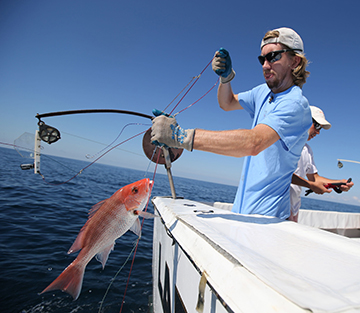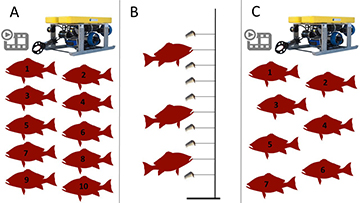The Great Red Snapper Count Depletion Studies
This publication describes the depletion studies phase of the Great Red Snapper Count, which is a 2-year research project to estimate the abundance of red snapper in the U.S. Gulf of Mexico.

Photo by Trey Spearman, Dauphin Island Sea Lab/University of South Alabama Fisheries Ecology Lab
What is a depletion study?
A depletion study is a scientific survey which collects two types of information: relative abundance (in our case, counts of red snapper relative to other species present) and absolute abundance (a known number of fish removed from the population).
Where are scientists conducting depletion studies?
Depletion studies for red snapper are being conducted at both natural and artificial habitat types.
How do scientists determine the abundance of red snapper from the depletion data?
The ratio of relative abundance to absolute abundance yields a population size estimate.
What types of depletion studies are being used to estimate abundance?
1. Index-Removal
- This method involves successive cycles of indexing (or counting) the population using video footage collected with a remotely operated vehicle (ROV), removing individuals from the population using hook-and-line gear, and then indexing again with the ROV.
- After at least one index-remove-index cycle is completed, the second index should be a reduction of the first index based on the number of individuals that were removed.

Photo by Outland Technology Inc.
2. Change-in-Ratio
- This method applies the same principles as index-removal but collects relative and absolute abundance data in a different way.
- Relative abundance is determined during scientific surveys immediately before and after a recreational fishing season, while absolute abundance is simply the number of fish removed by the recreational fishery.

Image by Amanda Jefferson, Mississippi State University/Mississippi-Alabama Sea Grant
Questions or comments? Contact the project team at snappercount@harteresearchinstitute.org. For more information, visit snappercount.org.
This independent study is being conducted by a leading team of red snapper scientists from across the Gulf of Mexico and beyond:

This publication was supported by the U.S. Department of Commerce’s National Oceanic and Atmospheric Administration under NOAA Award NA16OAR4170181, the Mississippi -Alabama Sea Grant Consortium, and the Mississippi State University Extension Service. The views expressed herein do not necessarily reflect the views of any of these organizations.
Publication 3303 (POD-01-19)
MASGP-18-019-04
By Amanda E. Jefferson, Extension Associate, and J. Marcus Drymon, PhD, Assistant Extension Professor, Coastal Research and Extension Center.
Produced by Agricultural Communications.
Mississippi State University is an equal opportunity institution. Discrimination in university employment, programs, or activities based on race, color, ethnicity, sex, pregnancy, religion, national origin, disability, age, sexual orientation, genetic information, status as a U.S. veteran, or any other status protected by applicable law is prohibited. Questions about equal opportunity programs or compliance should be directed to the Office of Compliance and Integrity, 56 Morgan Avenue, P.O. 6044, Mississippi State, MS 39762, (662) 325-5839.
Extension Service of Mississippi State University, cooperating with U.S. Department of Agriculture. Published in furtherance of Acts of Congress, May 8 and June 30, 1914. GARY B. JACKSON, Director
The Mississippi State University Extension Service is working to ensure all web content is accessible to all users. If you need assistance accessing any of our content, please email the webteam or call 662-325-2262.




